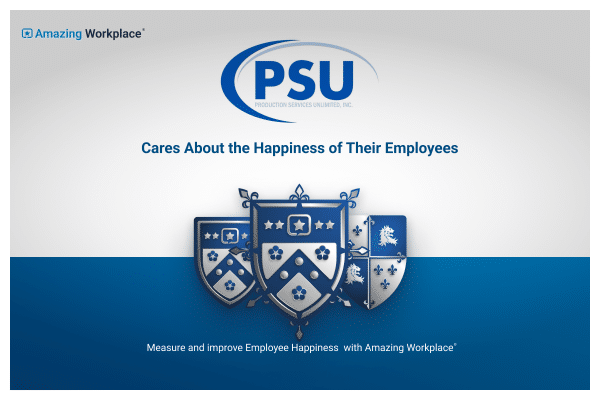How to Improve Safety Culture in the Workplace
What is a culture of safety & why is it important? Learn how to improve safety culture in the workplace, create positive values, & avoid undermining behaviors

While safety culture is often talked about in the healthcare field, it applies to any field. Creating and maintaining a safe workplace is extremely important, and a culture of safety should be a part of any successful business who hopes to be thought of as an Amazing Workplace.
What is a culture of safety? Our safety culture definition
Having a culture of safety definition is important to tackle the subject, as without an understanding of what it is exactly, then how could you be expected to do anything effective about it or deal with any safety issues that may arise in your business.
Definition: To put it simply, a safety culture is the combination of attitudes and behaviors toward patient safety that are conveyed when walking into a health facility.
A safety culture is not limited to healthcare, however. The concept is used in other high-risk industries, such as nuclear power and aviation, that seek to understand safety incidents to prevent future accidents or disasters.
A safety culture is viewed as an organization’s shared perceptions, beliefs, values, and attitudes that combine to create a commitment to safety and an effort to minimize harm.
Why is promoting a culture of safety important?
Even if you don’t work in a highly dangerous field, you can still take time to focus on safety in the workplace. Construction companies do this often, so do other industries such as stunt performers and so on. But the idea of keeping your employees safe in a work environment is never a bad idea, even if you work in an office with minimal opportunities for harmful accidents. Implementing safety protocols in any workplace will promote a safety climate for workers, avoid near misses, and provide a safe work space for all.
Keys to creating a culture of safety at work from the ground up
A company with a strong safety culture will usually experience far fewer behaviors which put employees at risk, and will consequently have lower accident rates, lower turnover, lower absenteeism and higher productivity. If you haven’t started the process of implementing such safety policies in your workplace, let’s dig in to how you might get started. Developing a safety culture will benefit your employees and building a safety culture will not only avoid harmful accidents but put your mind at ease over any safety concerns.
1. Make safety the responsibility of everyone
Safety culture needs to be driven from the top-down. Leadership and executives should lead by example, but holding managers and supervisors accountable for visibly being involved and encouraging every level of the company, no matter how high or low on the command chain to hold themselves and their colleagues to a high standard of safety practices and workplace safety.
2. Reporting
Corrective actions can’t be taken if no one reports an accident or breach of safety protocols. A major contributing factor to an unsafe workplace is that reports aren’t made or aren’t made in a timely manner to higher-ups. As a result, nothing gets done, or corrective improvements are made too slowly, which increases the risk to other employees.
Incident reporting of all injuries should be made part of your company’s core values. First aid issues and near misses should be reported to management. Employees should be brought up to speed on accident trends, and the importance of reporting all incidents. A small amount of attention to preventative measures is worth a lot in the long run.
3. Education and Training
Safety education and training needs to be part and parcel of any concept of safety culture. This includes making sure each and every employee is aware of company policies when it comes to procedures for doing work, employee safety training, company disciplinary policies, and safety and health policies. This should also include what to do in any situation where an accident or an injury occurs. First aid basic procedures should be learned, and specific procedures should be known well by all employees should any medical emergency arise.
4. Establish standards
Minimum standards for safety procedures, training, corrective actions, and continuous improvement need to be put in place. Obviously one should aim higher than minimum standards, but if those are set in place then one can’t drop below an acceptable level of a safe workplace with low-risk to one’s employees. Regulatory standards should be met wherever applicable, especially in fields that have regulatory agencies which set such minimum standards.
5. Regular inspections
Once standards are set in place, training and protocols are known and enforced, then it is imperative to maintain high standards by conducting regular inspections. The importance of safety can’t be understated, and keeping your team out of harm’s way can only be guaranteed by regularly checking in to see how things are going. You have to get out there and look. Note down any variations from standards and crack the whip on any violations of safety policies or rules.
How to maintain and improve safety culture in the workplace ongoing
Once a safety culture and procedures are set in motion, a company should know how to both maintain and improve upon existing safety measures such as corrective actions, procedural reviews, measuring the safety competencies of staff etc.
Improving safety culture needs to have full support from the C-level of your company. This way you have a top-down supportive structure that will not run into any resistance should improvements be suggested.
As discussed above, regular inspections of safety performance and safety protocols are essential to a proactive safety culture. Reviewing often with the intention of maintaining and improving your company’s safety record will ensure exactly that.
Having a goal of zero accidents is the ultimate, and should be the goal of your team and organizational culture. There should be a management commitment to reward any efforts that achieve this goal.
If you’re looking for the main ingredient of how to improve safety culture in the workplace, the answer to that is communication. Employees must be empowered with the proper resources and tools necessary to be effective at finding and fixing safety issues and communicating with their appropriate seniors. The more communication on the subject, the better. This keeps safety top of mind and reinforces management’s commitment to a health and safety culture as a strategic business objective and core value.
How to introduce employees to a safety culture change
Change is never easy, especially when introducing groups of people to new ideas, or when shifting procedures may interrupt the status quo of their work day. You may run in to a lot of eye rolls or groans, but reassure the team that it is far more important to keep a safe workplace and to endure a minor inconvenience so that you can all avoid a major accident or injury. Culture change in the workplace is never easy, and you are bound to run into some resistance.
Again, the reassurance from management that small amount of prevention is worth a large amount of peace of mind for all. If there are any major disagreements or new procedures disrupt work in a major way for anyone, then sit down and find a solution that will not only keep the safety of the workplace in mind, but also productivity as a whole.
What values ensure a culture of safety?
Workplace culture is often describes as “the way we do things around here”. Safety values should be an integral part of that.
Engaged management
When something is important to the management structure of a company, it becomes part of the way things are done, and is evident to all levels of that company that safety culture is important around here. A safety manager might even be appointed, whose job it is to coordinate and communicate safety issues between employees and management.
Communication
It could be argued that strong communication skills in any area will improve the overall culture of a business, but this is especially true when it comes to the safety and wellbeing of your employees. It should be encouraged to have honest and open discussions on the subject of safety policy, safety information, organizational safety, safety management systems, and anything relating to a strong and effective safety culture.
Encourage Reporting
To ensure a culture of safety, it needs to become part of the company’s fabric that it is encouraged to report any and all variations from the ideal in terms of safety standards. There could be “safety violation report” forms which are quickly written up as to what was observed, when it was observed, etc., and then handed to or sent via email to the Safety Manager. This way, as a collective, the company can be sure that everyone is doing their part to keep everyone else safe.
Behaviors that undermine a culture of safety
The human factor comes into play here, and there are always going to be things that can possibly erode a strong safety culture. Here are some to be on the lookout for.
Lack of or No reporting
When incidents are under-reported you are opening yourself up for trouble. It should be encouraged that even a small thing, when noticed by an employee in the office, on the shop floor, or out in the field, properly reported, can make a big difference and contribute to a safer worksite, and a safer workplace for all.
Lack of support for safety programs
If someone in the ranks is outwardly, or even quietly in disagreement of implementing safety procedures, you have a problem on your hands. Be on the lookout for remarks or outbursts that voice dissenting opinions against actions which contribute to a safe workplace. An uncooperative attitude will exhibit itself in many ways: refusal to perform safety tasks, making fun of safety training, “this is a waste of time” type-comments, etc.
Senior management not on board
Having the full support of senior management is essential to the success of any safety program and in the nurturing of a safety culture. When C-level executives view or treat safety programs as an annoyance, or an inconvenience not worth their time, you will inevitably find that this attitude seeps downward into the rest of the company culture.
Key takeaways on positive safety culture
Creating a safe work environment for your professionals is key to ensuring a more positive workplace culture, higher productivity from your employees, higher morale, and a lower case of accidents and injuries in the workplace. This is turn lowers absenteeism, injury costs and worker’s compensation costs, etc.
Communication is essential to the achievement of a safe workplace. Reporting systems need to be in place and upper level management needs to support safety programs fully. Having the responsibility of a safe and secure workplace fall on everyone’s shoulders will help to maintain and improve safety and wellbeing for all.
Training, education and regular inspections are key elements too.


